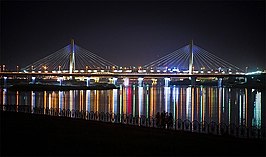
Back Ahvaz Afrikaans الأهواز Arabic الاهواز ARZ АхӀваз AV Əhvaz Azerbaijani اهواز AZB Ахваз Byelorussian Ахваз Bulgarian আহওয়াজ Bengali/Bangla ཨཱ་ཝཛ། Tibetan
Ahvaz
Persian: اهواز | |
|---|---|
City | |
|
From top: The white bridge, black bridge, Ahvaz at night, the triangle building of Shahid Chamran University, the shrine of Ali ibn Mahziar, Karun river, and the 8th bridge (Ghadir-bridge). | |
| Nickname: The City of Bridges | |
| Coordinates: 31°18′17″N 48°40′42″E / 31.30472°N 48.67833°E[1] | |
| Country | Iran |
| Province | Khuzestan |
| County | Ahvaz |
| District | Central |
| Area | |
| • City | 220 km2 (80 sq mi) |
| Elevation | 16 m (52 ft) |
| Population (2024 [3]) | |
| • Urban | 1.309.000 [2] |
| Demonym | Ahvazi |
| Time zone | UTC+3:30 (IRST) |
| Postal code | 61xxx |
| Area code | (+98) 61 |
| Climate | BWh |
| Website | www |
Ahvaz (Persian: اهواز; [ʔæhˈvɒːz] )[a] is a city in the Central District of Ahvaz County, Khuzestan province, Iran. It serves as capital of the province, the county, and the district.[4] It is home to Persians, Arabs, Bakhtiaris, Dezfulis, Shushtaris, and others.[5] Languages spoken in the area include Persian, Arabic, Luri and dialects such as Bakhtiari, Dezfuli and Shushtari.[6]
Ahvaz is home to over 1.2 million people within its metropolitan area, including Sheybani. Census results suggest a steady increase in population. At the time of the National Census of 2006, the city had 969,843 inhabitants in 212,097 households;[7] 1,112,021 people in 288,271 households in 2011;[8] and in 2016 the census counted 1,184,788 people in 331,556 households.[9]
The river Karun flows through the middle of the city. It is one of the two navigable rivers in Iran, alongside the Arvand Rud.[10] Ahvaz has a long history, dating back to the Achaemenid period. In ancient times, the city was one of the main centers of the Academy of Gondishapur.
- ^ OpenStreetMap contributors (22 July 2023). "Ahvaz, Ahvaz County" (Map). OpenStreetMap (in Persian). Retrieved 22 July 2023.
- ^ [1]
- ^ [2]
- ^ Habibi, Hassan. "Approval of the organization and chain of citizenship of the elements and units of the national divisions of Khuzestan province, centered in the city of Ahvaz". Islamic Parliament Research Center (in Persian). Ministry of Interior, Political and Defense Commission of the Government Board. Archived from the original on 17 July 2014. Retrieved 25 January 2024.
- ^ Getting know to Ahvaz aparat.com Retrieved 5 May 2018
- ^ AbdulHussain Sa'dian, Land and people of Iran, Anthropology and ceremonies of Iranian ethnicities, publishers science and life, pp. 463–463.
- ^ "Census of the Islamic Republic of Iran, 1385 (2006)". AMAR (in Persian). The Statistical Center of Iran. p. 06. Archived from the original (Excel) on 20 September 2011. Retrieved 25 September 2022.
- ^ "Census of the Islamic Republic of Iran, 1390 (2011)". Syracuse University (in Persian). The Statistical Center of Iran. p. 06. Archived from the original (Excel) on 18 January 2023. Retrieved 19 December 2022.
- ^ "Census of the Islamic Republic of Iran, 1395 (2016)". AMAR (in Persian). The Statistical Center of Iran. p. 06. Archived from the original (Excel) on 21 October 2020. Retrieved 19 December 2022.
- ^ "Khuzestan (Iran): Counties & Cities - Population Statistics, Charts and Map". www.citypopulation.de.
Cite error: There are <ref group=lower-alpha> tags or {{efn}} templates on this page, but the references will not show without a {{reflist|group=lower-alpha}} template or {{notelist}} template (see the help page).









